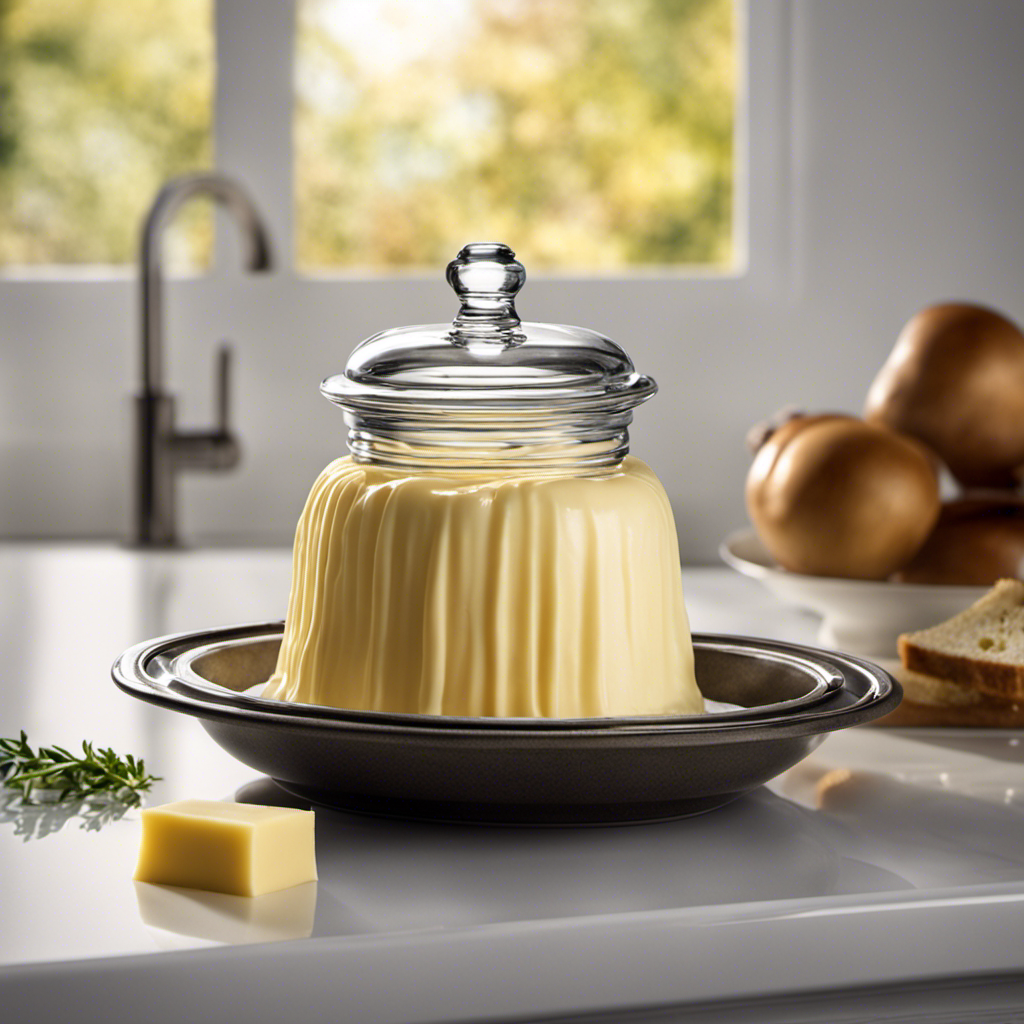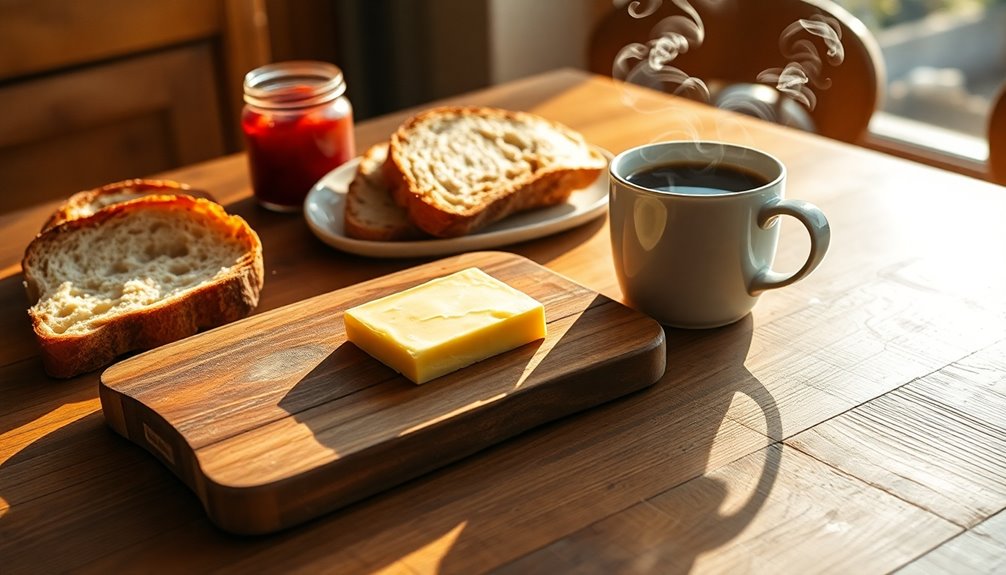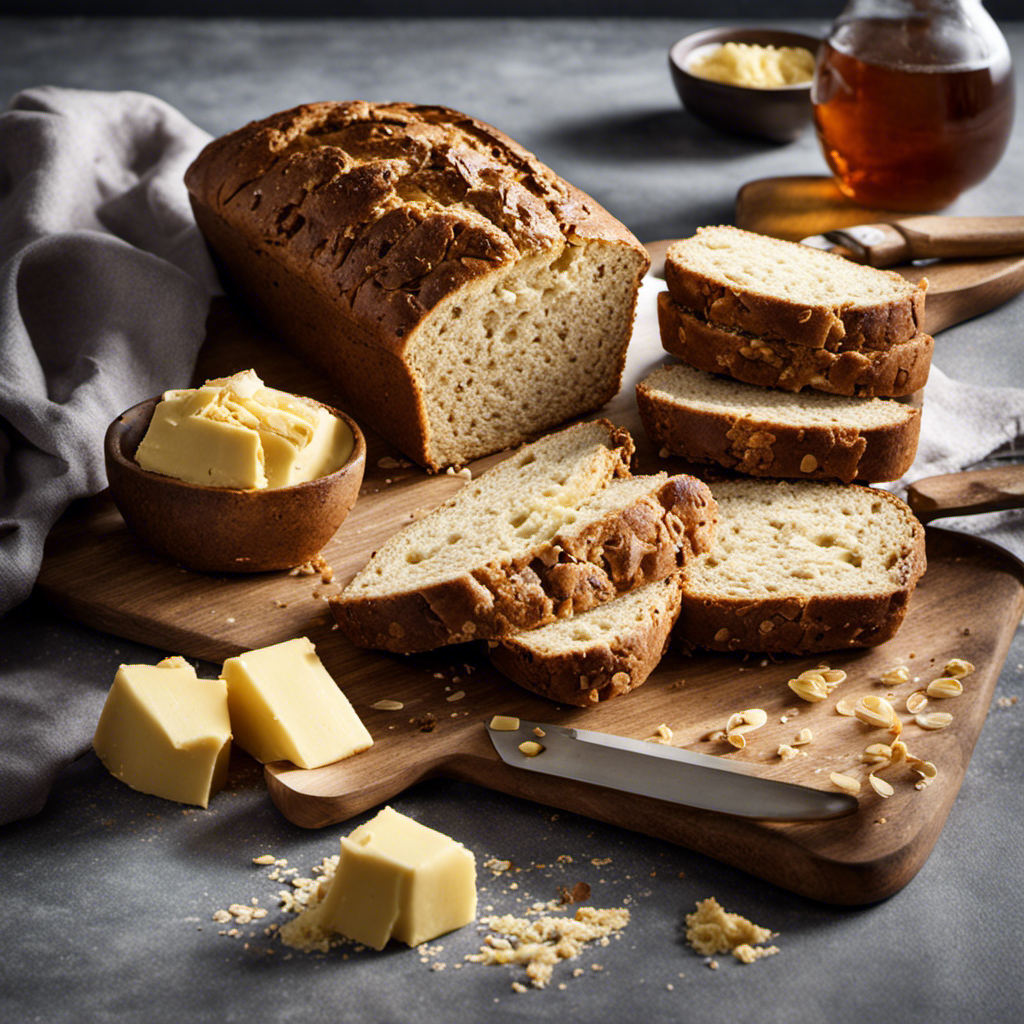As I sit down to enjoy a warm slice of bread, I am thoroughly impressed by the ingenuity of the butter bell.
This simple yet effective contraption has revolutionized the way we store and spread our beloved butter.
But how does it work? In this article, we will delve into the fascinating history, design, and science behind the butter bell.
Prepare to be amazed as we uncover the secrets of this culinary marvel.
Key Takeaways
- The butter bell originated in France during the 16th century and was used to store and preserve butter.
- A butter bell consists of a base and a lid, with the base filled with water to create an airtight seal.
- The water in the base acts as a barrier to preserve the texture and taste of butter, providing a longer shelf life.
- Using a butter bell eliminates the need for refrigeration and ensures fresh, spreadable, and delicious butter at all times.
History of the Butter Bell
The history of the butter bell dates back to the 16th century. Its origins can be traced to France, where it was initially used to store and preserve butter.
The butter bell consists of two parts – a base and a lid. The base is filled with water, creating an airtight seal when the lid is placed on top. This unique design helps to keep the butter fresh and spreadable for longer periods of time.
The cultural significance of the butter bell is evident in its usage across different countries and communities. It has become a staple in many households, symbolizing tradition and the importance of preserving food.
Today, the butter bell continues to be a popular and practical kitchen tool, cherished for its historical roots and practical function.
Understanding the Design of a Butter Bell
To understand the design of a butter bell, it’s important to recognize its purpose and functionality. A butter bell is a simple yet ingenious device that allows for the convenient storage and spreading of butter at room temperature. The construction of a butter bell typically consists of two parts: a base and a lid. The base is filled with water, creating an airtight seal when the lid is placed on top. This seal prevents air from reaching the butter, keeping it fresh and spreadable for an extended period. The functionality of a butter bell is based on the principle of water acting as a barrier between the butter and the air. By submerging the butter in water, the butter bell creates an environment that preserves the butter’s texture and taste. The table below summarizes the construction and functionality of a butter bell:
| Construction | Functionality |
|---|---|
| Base filled with water | Creates an airtight seal |
| Lid placed on top | Prevents air from reaching the butter |
| Water acts as a barrier | Preserves the butter’s texture and taste |
The Science Behind a Butter Bell
If you want to understand the science behind a butter bell, you should know that it relies on the principle of water creating an airtight seal to preserve the texture and taste of the butter. This simple yet effective technology provides several benefits:
-
Longer shelf life: By creating an airtight seal, a butter bell prevents air and moisture from reaching the butter, keeping it fresh for longer periods.
-
Soft and spreadable butter: The water in the base of the butter bell helps maintain a cool temperature, preventing the butter from melting and becoming too soft.
-
Easy to use: With a butter bell, you can conveniently store and access your butter without the need for refrigeration, making it perfect for everyday use.
The butter bell technology combines the science of water’s sealing properties with the practicality of preserving butter’s texture and taste. It’s a simple yet ingenious solution for butter lovers everywhere.
How to Use a Butter Bell in Your Kitchen
When it comes to preserving butter, there are a variety of techniques to consider. In this discussion, I will explore the different butter preservation techniques and their effectiveness.
Additionally, I will highlight the benefits of using a butter bell in your kitchen for long-lasting freshness and convenience.
Butter Preservation Techniques
One of the most popular butter preservation techniques is using a butter bell. This traditional method has been used for centuries and is still widely practiced today.
Alternatives to butter bells include using a butter dish or keeping butter in the refrigerator, but they may not provide the same level of freshness and spreadability.
Butter preservation holds cultural significance in many societies, as butter is a staple in their cuisine and preserving it ensures its availability year-round.
The butter bell works by keeping the butter in an airtight container, submerged in water. This creates a seal that prevents air and bacteria from reaching the butter, keeping it fresh and spreadable for longer periods.
Using a butter bell has several benefits, including maintaining the flavor and texture of the butter and eliminating the need for refrigeration.
Benefits of Using Butter Bell
The benefits of using a butter bell include preserving the flavor and texture of the butter, as well as eliminating the need for refrigeration. A butter bell is a simple yet effective device that consists of two parts: a base and a lid.
The base holds water, creating a seal that keeps the butter fresh and spreadable for extended periods. By keeping the butter at room temperature, the butter bell maintains its optimal consistency, allowing for easy spreading on bread or toast.
Additionally, the butter bell prevents the butter from absorbing odors from the refrigerator, ensuring that it retains its original taste. The advantages of using a butter bell are clear – it keeps the butter fresh, spreadable, and delicious, all without the need for refrigeration.
With a butter bell, you can enjoy perfectly preserved butter whenever you need it.
Benefits of Using a Butter Bell
Using a butter bell has several benefits. It helps to keep the butter fresh for longer periods of time by creating an airtight seal. This prevents the butter from becoming rancid and allows it to maintain its flavor and texture.
Additionally, the butter in a butter bell is soft and spreadable at all times. This makes it convenient and effortless to spread on bread or toast.
Longer Lasting Butter
To make your butter last longer, simply store it in a butter bell. However, if you don’t have a butter bell, there are alternative methods to store your butter and keep it fresh. Here are a few options:
- Wrap the butter tightly in wax paper or parchment paper to prevent air exposure.
- Place the wrapped butter in an airtight container or a resealable plastic bag to further protect it.
- Store the container in the coldest part of your refrigerator, preferably in the dairy compartment.
These methods help to maintain the butter’s freshness and prevent it from absorbing any odors from other foods in the fridge. By implementing these alternatives, you can ensure that your butter stays fresh for an extended period.
Now that we’ve covered how to store butter to make it last longer, let’s move on to the next section: how using a butter bell can make your butter easier to spread.
Easy to Spread
After learning about the longer lasting properties of a butter bell, it’s time to explore another benefit – easy spreading.
The butter bell’s design ensures a smooth and consistent butter consistency, making it effortless to spread on bread or toast. This is achieved through the unique combination of the butter bell’s water seal and the butter itself.
The water creates an airtight seal, preventing any air from reaching the butter and causing it to oxidize. As a result, the butter remains soft and spreadable, even at room temperature. The butter bell’s ceramic container also helps to maintain the ideal temperature, further enhancing the butter’s easy spreading qualities.
Different Types and Materials of Butter Bells
You’ll find that there are various types and materials of butter bells to choose from. When it comes to butter bells, there are three main options that you can consider:
-
Ceramic butter bells: These are the most common type and are made from ceramic materials. They are known for their durability and ability to keep butter fresh for longer periods of time.
-
Stoneware butter bells: These butter bells are made from stoneware materials, which are known for their heat retention properties. Stoneware butter bells are great for keeping butter soft and spreadable, even in warmer temperatures.
-
Porcelain butter bells: Porcelain butter bells are elegant and delicate in design. They are known for their ability to maintain the freshness and flavor of butter.
Using a butter bell has several advantages. It keeps butter at the perfect temperature for spreading, prevents it from spoiling, and enhances the flavor of your butter.
Additionally, butter bells are often stylish and can be a beautiful addition to your kitchen.
Maintaining and Cleaning Your Butter Bell
When cleaning your butter bell, it’s important to use warm soapy water and avoid harsh scrubbing brushes. Proper maintenance and cleaning of your butter bell will help ensure its longevity and effectiveness in keeping your butter fresh.
Begin by removing any leftover butter from the bell, then fill it with warm water and a small amount of mild dish soap. Gently swirl the water inside the bell to loosen any residue. Rinse the bell thoroughly with warm water, making sure to remove all soap residue.
Avoid using abrasive brushes or scouring pads, as they can damage the delicate surface of the bell. Once cleaned, allow the bell to air dry completely before using it again.
Regular cleaning and maintenance will help keep your butter bell in optimal condition for years to come.
Troubleshooting Common Issues With a Butter Bell
To troubleshoot common issues with your butter bell, try adjusting the temperature of your butter or experimenting with different types of butter. Some common butter bell problems include:
-
Butter sticking to the lid: This could be due to the butter being too soft. Try refrigerating the butter for a while before placing it in the bell.
-
Mold growth: If you notice mold growing on your butter, it could be because the butter is too warm. Make sure to keep the butter bell in a cool and dry place.
-
Hard butter: If your butter is too hard to spread, it might be because the temperature in the room is too cold. You can try placing the butter bell in a warmer area to soften the butter.
By addressing these common issues, you can ensure that your butter bell functions properly and keeps your butter fresh and spreadable.
Now, let’s move on to some tips and tricks for getting the most out of your butter bell.
Tips and Tricks for Getting the Most Out of Your Butter Bell
When it comes to storing butter, proper storage conditions and choosing the right butter are crucial factors.
To ensure the freshness and quality of your butter, it is important to store it in the appropriate conditions, such as keeping it in a covered dish or butter bell at room temperature.
Additionally, selecting the right type of butter, whether it be salted or unsalted, can greatly impact the taste and texture of your dishes.
Proper Storage Conditions
Proper storage conditions for a butter bell include keeping it in a cool and dark place. This ensures that the butter stays fresh and doesn’t spoil quickly. Here are some tips for optimal butter storage:
- Keep the butter bell away from direct sunlight, as exposure to light can cause the butter to soften and melt.
- Store the butter bell in a cool place, such as a pantry or refrigerator, to maintain its firmness and prevent it from becoming too soft.
- Make sure to cover the butter bell tightly to protect it from odors and contaminants in the environment.
Choosing the Right Butter
Choosing the right butter can enhance the flavor of your favorite recipes. When it comes to selecting butter, there are a few factors to consider. One important aspect is the type of butter, whether it is salted or unsalted. Salted butter can add a subtle savory note to dishes, while unsalted butter allows for better control of the saltiness in your recipes. Additionally, the quality of the butter plays a crucial role. Look for butter made from high-quality cream, as it will have a richer and more flavorful taste. Finally, consider the butter’s freshness and storage conditions. Properly storing butter in an airtight container in the refrigerator can help maintain its freshness and prevent it from absorbing any unwanted odors. By choosing the right butter and storing it effectively, you can elevate the taste of your culinary creations.
| Factors to Consider | Salted Butter | Unsalted Butter |
|---|---|---|
| Flavor | Savory | Neutral |
| Control over Salt | Limited | Full Control |
| Freshness | Moderate | Moderate |
Butter Bell Vs. Traditional Butter Dishes: a Comparison
The main difference between a Butter Bell and traditional butter dishes is how they keep the butter fresh. When comparing the two, there are several advantages of using a butter bell:
- The design of a butter bell allows for the butter to be stored in an airtight container, keeping it fresh and spreadable for longer periods of time.
- The water in the base of the butter bell creates a seal, preventing air from reaching the butter and preventing spoilage.
- The water also acts as a barrier, preventing any unwanted odors or flavors from contaminating the butter.
In contrast, traditional butter dishes do not have the same airtight seal and rely on refrigeration to keep the butter fresh. However, using a butter bell eliminates the need for refrigeration and provides a convenient and attractive way to store and serve butter at room temperature.
Exploring Butter Bell Variations and Innovations
To get the most out of your butter bell, you’ll want to explore the various innovative variations available on the market. These butter bell innovations offer unique features and designs that enhance the functionality and convenience of this traditional kitchen tool.
Below is a table showcasing some of the popular butter bell variations and their key features:
| Variation | Key Features |
|---|---|
| Insulated | Keeps butter colder for longer |
| Stoneware | Provides a rustic and elegant look |
| Adjustable | Allows for different butter sizes |
| Decorative | Adds a touch of style to your table |
| Dishwasher-safe | Easy to clean and maintain |
These butter bell variations cater to different preferences and needs. Whether you prefer a stylish design or a practical feature, there is a butter bell variation that will suit your requirements. By exploring these innovations, you can find the perfect butter bell to enhance your butter storage experience.
Frequently Asked Questions
How Long Can You Keep Butter in a Butter Bell?
You can keep butter in a butter bell for up to 30 days, as long as you properly clean the bell and choose the right size for your needs. It’s a convenient way to keep butter fresh and spreadable.
Can You Use Any Type of Butter in a Butter Bell?
Can you use any type of butter in a butter bell? Well, it’s a butter bell, not a butter wizard. Stick to regular butter or unsalted butter for best results. Ghee? Not recommended.
Can You Use a Butter Bell for Margarine or Other Spreads?
Yes, a butter bell can be used for margarine or other spreads. It keeps them fresh and spreadable, just like it does with butter. This is one of the alternative uses for a butter bell.
Can You Use a Butter Bell for Storing Other Food Items?
Yes, a butter bell can be used for storing other food items. It can keep soft cheeses, herbs, and even small portions of leftover dips fresh. The air-tight seal preserves their taste and texture.
Can You Microwave the Butter in a Butter Bell?
No, you can’t microwave butter in a butter bell. Microwaving limitations include the risk of melting the bell and altering the butter’s texture. Alternative heating methods like room temperature or warm water are recommended.
Conclusion
In conclusion, the butter bell is a remarkable invention that has revolutionized the way we store and enjoy butter. Its clever design and scientific principles ensure that our butter stays fresh and spreadable for longer periods of time.
By using a butter bell in our kitchens, we can effortlessly preserve the creamy goodness of butter without any hassle. The various benefits and innovations of the butter bell make it a must-have for any butter lover.
So why settle for ordinary butter dishes when you can indulge in the wonders of a butter bell?










